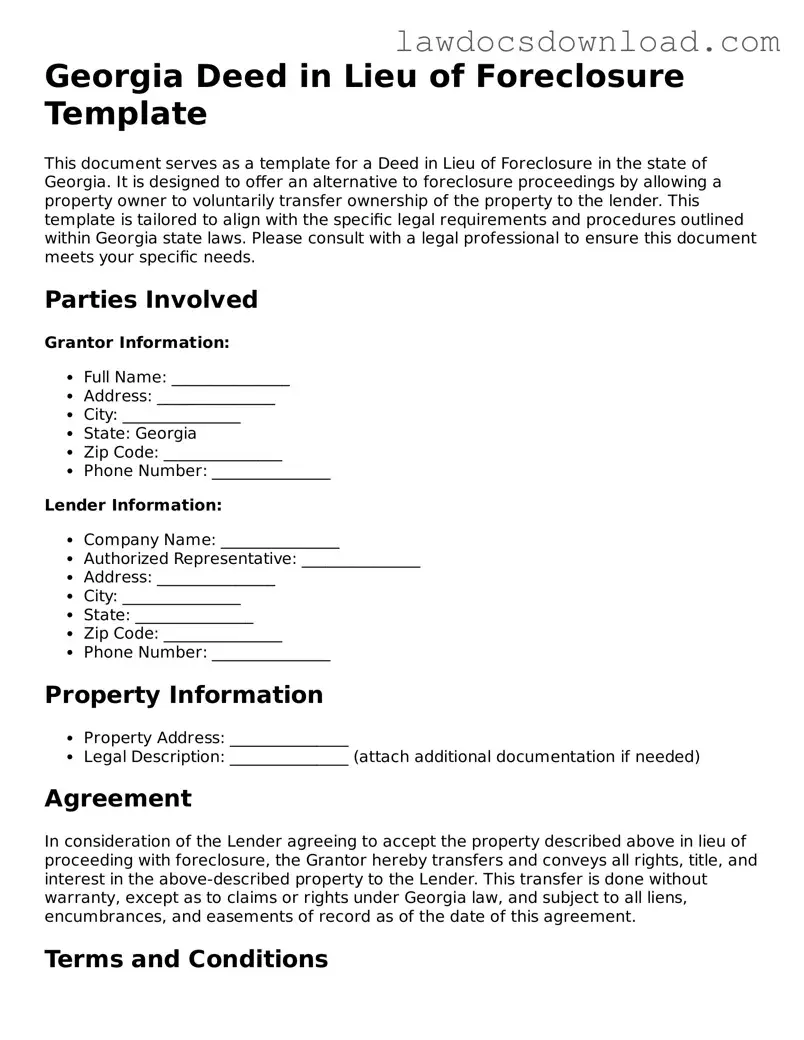The Georgia Deed in Lieu of Foreclosure form shares similarities with a Mortgage Agreement. Both documents are crucial in the process of purchasing or refinancing a property. A Mortgage Agreement outlines the borrower's promise to repay the loan used to buy the home, while the Deed in Lieu of Foreclosure is a method used to avoid foreclosure. Essentially, both play significant roles in managing the financial aspects of home ownership, involving the legal rights concerning the property.
Comparable to a Quitclaim Deed, the Georgia Deed in Lieu of Foreclosure form serves as a legal instrument transferring property ownership. However, a Quitclaim Deed does this without any guarantees about the property's clear title, primarily used between family members or to clear up title issues. In contrast, a Deed in Lieu transfers the property back to the lender to satisfy a loan that is in default, potentially offering a cleaner break from the mortgage obligations.
Loan Modification Agreement forms also share common ground with the Deed in Lieu of Foreclosure. These documents are avenues for borrowers facing financial hardship to alter the terms of their mortgage, aiming to make payments more manageable and avoid foreclosure. While a Loan Modification Agreement adjusts the terms of the existing mortgage, the Deed in Lieu of Foreclosure acts as a final step to settle the debt by transferring property ownership back to the lender.
Foreclosure forms, necessary for the legal process wherein a lender attempts to recover the balance of a loan from a borrower who has stopped making payments, are akin to the Deed in Lieu of Foreclosure form. Both are used in situations where borrowers are unable to fulfill their mortgage commitments. However, while foreclosure typically involves the forced sale of the property to repay the debt, a Deed in Lieu of Foreclosure is a voluntary surrender of the property to the lender.
Short Sale Agreement forms are another related document. When a borrower can no longer afford their mortgage payments, a short sale allows the property to be sold for less than the amount owed on the mortgage, with the lender's approval. This is considered an alternative to foreclosure or a Deed in Lieu of Foreclosure, with the goal of mitigating financial loss for both the borrower and the lender.
Bankruptcy forms intersect with the purposes of a Deed in Lieu of Foreclosure as they both represent tools for individuals facing insurmountable financial challenges. Bankruptcy offers a way to either restructure debts or liquidate assets under court supervision to pay off creditors, providing a fresh start. Meanwhile, a Deed in Lieu of Foreclosure specifically addresses the issue of an unaffordable mortgage, allowing the borrower to avoid the ramifications of a foreclosure on their credit report.
The Warranty Deed, similar to the Deed in Lieu of Foreclosure, involves the transfer of property. However, it comes with a guarantee from the seller to the buyer that the title is clear of any claims, offering a higher level of protection for the buyer. This contrasts with a Deed in Lieu of Foreclosure, where the transfer occurs due to the inability to meet mortgage obligations, without the implied warranties found in a Warranty Deed.
Assignment of Rent forms also relate closely. Landlords or property owners use these to redirect rental income from tenants directly to a lender if they default on their loan. Like a Deed in Lieu of Foreclosure, this is a strategy for handling financial distress related to property. However, it focuses on generating income from the property to satisfy debt obligations, rather than transferring property ownership.
A Deed of Trust is another document sharing a purpose with the Deed in Lieu of Foreclosure. It secures a real estate transaction by holding the property title in trust for the lender until the borrower repays their debt. In contrast, the Deed in Lieu of Foreclosure steps in once the borrower is unable to meet the repayment terms, providing an alternative method to settle the outstanding mortgage without going through foreclosure.
Lastly, Eviction Notice forms, while primarily used by landlords to remove tenants for lease violations or non-payment, connect with the essence of a Deed in Lieu of Foreclosure. Both documents represent legal solutions to financial disputes involving property. An Eviction Notice forces a resolution to a rental agreement issue, whereas a Deed in Lieu of Foreclosure resolves mortgage payment failures without the complexities of a foreclosure process.
